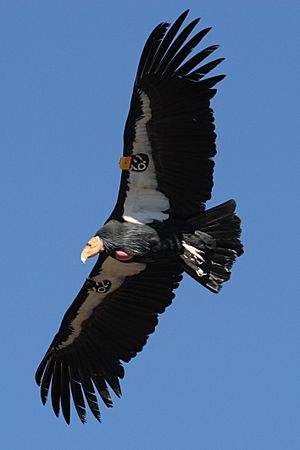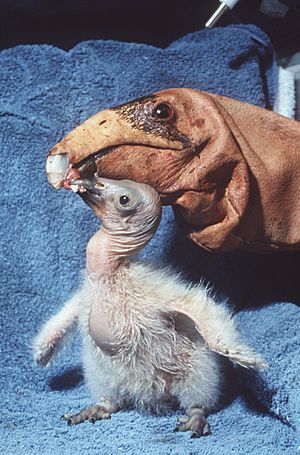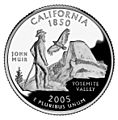California Condor facts for kids
Quick facts for kids Andean condor |
|
|---|---|
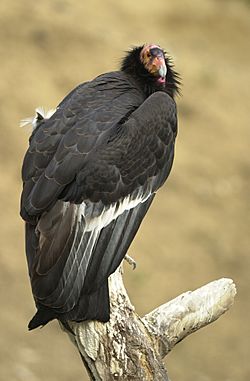 |
|
| Conservation status | |
| Scientific classification | |
| Kingdom: | |
| Class: | |
| Order: | |
| Family: | |
| Genus: |
Gymnogyps
|
| Binomial name | |
| Gymnogyps californianus Shaw, 1797
|
|
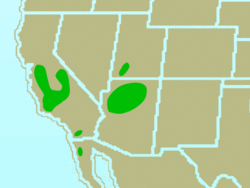 |
|
| California Condor distribution
Yellow – range/distribution |
|
The California Condor (Gymnogyps californianus) is a huge bird found in North America. It belongs to the New World vulture family. This makes it the largest land bird in North America! Today, you can only find these amazing condors in places like the Grand Canyon area, Zion National Park, and the western mountains of California and northern Baja California. While other similar birds lived long ago, the California Condor is the only one left from its group, Gymnogyps.
This condor is a big, black vulture. It has white patches under its wings. Its head is mostly bald, and its skin can change from yellowish to bright red depending on how the bird feels. It has the widest wingspan of any bird in North America and is one of the heaviest. Condors are scavengers, meaning they eat large amounts of dead animals. They are also one of the world's longest-living birds, often living up to 50 years!
In the 1800s, the number of condors dropped a lot. This happened because of poaching (illegal hunting), lead poisoning, and losing their homes. To save them, the United States government started a conservation plan. In 1987, all 22 remaining wild condors were caught. These birds were then bred at the San Diego Zoo Safari Park and the Los Angeles Zoo. Their numbers grew thanks to this captive breeding program. Since 1991, condors have been released back into the wild. This project is the most expensive effort ever to save a species in the United States. The California Condor is now one of the rarest birds on Earth. By April 2009, there were 322 condors alive, with 172 of them living in the wild.
The condor is a very important bird to many Native American groups in California. It plays a big part in several of their traditional myths.
Contents
About the California Condor
The California Condor was first described by a scientist named George Shaw in 1797. He called it Vultur californianus. At first, it was grouped with the Andean condor. But because the Andean Condor has slightly different markings, longer wings, and sometimes hunts small animals, the California Condor now has its own special group, Gymnogyps. The name Gymnogyps comes from Greek words meaning "naked vulture." The name californianus simply means "from California." The word "condor" itself comes from the Ecuadorian Quechua word cuntur.
Scientists are still figuring out the exact family tree for the California Condor and other New World vultures. Even though they look similar to Old World vultures, they evolved from different ancestors in different parts of the world. Some scientists even thought New World vultures were more closely related to storks! Today, most agree they are either in the same group as Old World vultures or in their own special group called Cathartiformes.
Evolutionary History
The Gymnogyps group, which the California Condor belongs to, used to be found all over the Americas during the Pleistocene ice age. Fossils show that other condors like Gymnogyps kofordi lived in Florida, and Gymnogyps howardae lived in Peru. A condor found in Cuba was also a member of this group. It might even have been a type of California Condor.
Today's California Condor is the only one left from the Gymnogyps group. It doesn't have any different types (subspecies) that are recognized today. Even though its home range became much smaller after the last ice age, the species always had a small number of birds. However, there was a larger ancient type, Gymnogyps californianus amplus. This bird lived in many of the same places as today's condor, even in Florida. It was about the same size as the Andean condor and had a wider beak. As the climate changed after the last ice age, these condors became smaller. Over time, they evolved into the Gymnogyps californianus californianus we see today.
What Does a Condor Look Like?
An adult California Condor is mostly black. Males often have large white triangle shapes or bands under their wings. They have gray legs and feet, an ivory-colored beak, and a ruffle of black feathers around their neck. Their eyes are brownish-red. Young condors are mostly mottled dark brown with blackish heads. They have mottled gray under their flight feathers instead of white.
Condors have very few feathers on their head and neck. This helps them stay clean. It also lets the sun's ultraviolet light kill germs on their skin at high altitudes. The skin on their head and neck can change color, from yellowish to a bright reddish-orange. This change shows how the bird is feeling and helps them communicate with each other.
Unlike most birds of prey, the female condor is smaller than the male. California Condors can be from 117 to 135 centimeters (46 to 53 inches) long. Their wingspan is usually around 2.77 meters (9.1 feet). They can weigh from 7 to 14 kilograms (15 to 31 pounds). Most of these measurements come from condors raised by humans. So, it's hard to know if wild condors are much different in size.
California Condors have the largest wingspan of any North American bird. Only the Trumpeter swan and the Mute swan are longer and heavier. The American white pelican and Whooping crane also have longer bodies than the condor. Condors are so big that people sometimes mistake them for small, faraway airplanes!
The middle toe of a California Condor's foot is very long. The back toe is only slightly developed. Their talons are straight and blunt. This means their feet are better for walking than for grabbing things. This is more like storks than like other birds of prey or Old World vultures, which use their feet to hunt or hold things.
Where Do Condors Live?
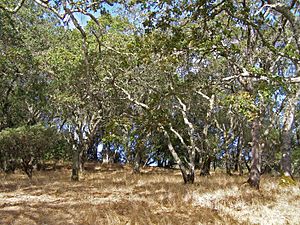
Five hundred years ago, California Condors lived all across the Southwestern United States and the West Coast of the United States. But their numbers dropped a lot. In 1987, the very last wild condor was taken into captivity for the breeding program. Recently, condors raised by humans have been set free in southern California, Baja California, and near the Grand Canyon. There are two special places just for these birds: the Sisquoc Condor Sanctuary and the Sespe Condor Sanctuary. These areas were chosen because they have great places for condors to build nests.
Condors live in rocky areas with scrubland, coniferous forests, and oak savannas. They often stay near cliffs or large trees, which they use for nesting. Individual condors can travel very far. They have been known to fly up to 250 kilometers (150 miles) to find food.
Ecology and Behavior
When a condor is in flight, it moves very gracefully. They are mostly soarers, meaning they glide a lot. They flap their wings when taking off from the ground. But once they are high enough, they mostly glide, sometimes for miles without flapping their wings even once. They can fly as fast as 90 km/h (55 mph) and as high as 4,600 meters (15,000 feet). They like to rest on high spots where they can easily launch themselves into the air without much wing flapping. You often see these birds soaring near rock cliffs, using warm air currents to help them stay up.
The California Condor lives a long time, up to 50 years. If a condor makes it to adulthood, it has very few natural enemies other than humans. They don't make many sounds, mostly just grunts and hisses. Condors bathe often and can spend hours cleaning their feathers. They also do something called urohydrosis, which means they poop on their legs to cool down their bodies. Condors in large groups have a clear social order. They use body language, playful actions, and different grunts and hisses to decide who is in charge. This social order is especially clear when they eat, with the older, more dominant birds eating first.
What Do Condors Eat?
Wild condors travel over large areas, sometimes 250 kilometers (150 miles) a day, looking for dead animals. Scientists think that long ago, California Condors ate the bodies of very large animals, like the "megafauna" that are now extinct in North America. Today, they still prefer to eat large dead mammals. These include deer, goats, sheeps, donkeys, horses, pigs, mountain lions, bears, or cattle. They might also eat smaller mammals like rabbits or coyotes. Sometimes, they eat dead aquatic mammals like whales and sea lions, or even salmon. They rarely eat dead birds or reptiles.
Condors don't have a good sense of smell. So, they find dead animals by watching for other scavengers, like smaller vultures and eagles. These smaller birds can't rip through the tough hides of large animals as easily as a condor can. Condors can usually scare other scavengers away from a carcass. Bears, however, will ignore them. Golden eagles might even fight a condor over food. In the wild, condors don't eat every day. They might go from a few days to two weeks without eating. Then, they will eat a lot at once, sometimes 1 to 1.5 kilograms (2 to 3 pounds) of meat. They can eat so much that they can't even fly off the ground!
Condor Life Cycle
Condors start looking for a mate when they are about six years old. To attract a mate, the male condor performs a special display. He turns his head red and puffs out his neck feathers. Then, he spreads his wings and slowly walks toward the female. If the female lowers her head, they become mates for life.
The condor pair builds a simple nest in caves or on cliff ledges. They especially like places with nearby trees for resting and open areas for landing. A mated female lays one bluish-white egg every other February or March. The egg weighs about 280 grams (10 oz). It is about 90 to 120 millimeters (3½ to 4¾ inches) long and about 67 millimeters (2⅝ inches) wide. If the chick or egg is lost, the parents will "double clutch." This means they lay another egg to replace the lost one. Scientists and breeders use this behavior to help more condors be born. They take the first egg to raise it by hand. This makes the parents lay a second egg, which they are sometimes allowed to raise themselves.
The eggs hatch after 53 to 60 days. Both parents take turns sitting on the egg to keep it warm. Chicks are born with their eyes open. It can take up to a week for them to fully hatch from their egg. Young condors are covered with grayish fuzz until they are almost as big as their parents. They can fly after five to six months. But they stay with their parents, resting and hunting, until they are two years old. At that point, a new chick takes their place.
Saving the Condors
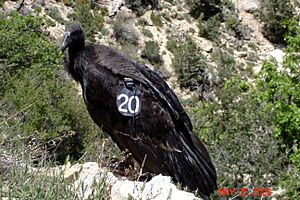
When humans first settled the Americas, the California Condor lived across much of North America. But changes in climate at the end of the last ice age and the disappearance of large animals (megafauna) led to fewer condors and a smaller home range. In ancient times, California Condors were found in Arizona, Nevada, New Mexico, and Texas.
In more recent times, many things caused the condor's numbers to drop. They have very specific mating habits and lay few eggs. They also mature late. This makes them easily affected by population loss. A lot of harm to condors came from poaching (illegal hunting), especially for museum collections. Other problems included lead poisoning (from eating animals shot with lead bullets), DDT poisoning, hitting power lines, egg collecting, and losing their homes. During the California Gold Rush, some condors were even kept as pets.
Also, cattle ranchers who saw condors eating dead young cattle mistakenly thought the birds killed the cattle. This wrong idea led to condors disappearing from some parts of the western United States. This belief was so strong that some ranchers even argued against bringing condors back to the Grand Canyon. They wrongly believed the birds hunted calves and lambs.
As the condor population kept shrinking, people started talking about a program to breed them in captivity. Some people disagreed. They said condors should be free, that capturing them all would change their habits forever, and that it would cost too much. But the United States Government approved the project. On Easter Sunday in 1987, AC-9, the last wild condor, was captured. There were only 22 condors left, all in captivity. The breeding program, run by the San Diego Zoo Safari Park and Los Angeles Zoo, started slowly because of the condor's mating habits. But biologists used the condor's ability to "double clutch" (lay a second egg if the first is removed). They started taking the first egg from the nest and raising it with puppets. This made the parents lay another egg.
As the number of condors grew, people started thinking about releasing some back into the wild. In 1988, the US Fish and Wildlife Service tried an experiment. They released captive Andean condors in California. Only females were released so that a South American species wouldn't accidentally start living in the United States. The experiment worked well. All the Andean Condors were caught again and released back in South America. California Condors were released in 1991 and 1992 in California. They were released again in 1996 in Arizona near the Grand Canyon. Even though the birth rate in the wild is still low, their numbers are slowly increasing. This is thanks to regular releases of young condors raised by humans.
Some condors released into the wild died unexpectedly. This happened because of fights with Golden eagles, hitting power lines, and other things like lead poisoning. Since 1994, condors raised in captivity have been trained to avoid power lines and people. This training program has greatly reduced the number of condor deaths from power lines. Lead poisoning from broken lead bullets in dead animals is a big problem for condors. This is because their very strong stomach acids can dissolve the lead. This lead waste is not as big a problem for other bird scavengers like the Turkey vulture and Common raven. To help with this, California passed a law called the Ridley-Tree Condor Preservation Act. Since July 1, 2008, this law requires hunters to use non-lead bullets when hunting in areas where condors live.
The California Condor conservation project is the most expensive species saving project in United States history. It has cost over $35 million since World War II. This includes $20 million from the government. However, the reintroduced condors have reached important milestones. In 2003, the first condor chick successfully flew from a wild nest since 1981. In March 2006, a pair of California Condors tried to nest in a hollow tree near Big Sur, California. This was the first time in over 100 years that a pair of California Condors had been seen nesting in Northern California. In early 2007, a California condor laid an egg in Mexico for the first time since at least the 1930s. The number of condors has grown because of these wild and captive nestings. As of April 2009, there are 322 condors alive. 172 of them are in the wild. The rest are in places like the San Diego Wild Animal Park, the Los Angeles Zoo, the Oregon Zoo, or the World Center for Birds of Prey in Boise, Idaho.
Condors in Native American Stories
Throughout the areas where it used to live, the California Condor has been a popular subject in mythology. It is an important symbol to Native Americans. Interestingly, this bird plays different roles in the stories of different tribes.
The Wiyot tribe of California says that the condor created humans again after Above Old Man destroyed humanity with a flood. However, other tribes, like California's Mono, saw the condor as a destroyer, not a creator. They say that Condor grabbed humans, cut off their heads, and drained their blood. This blood flooded Ground Squirrel's home. Condor then grabbed Ground Squirrel after he ran away. But Ground Squirrel managed to cut off Condor's head when Condor stopped to drink the blood. According to the Yokuts tribe, the condor sometimes ate the moon, which caused the lunar cycle. They also believed his wings caused eclipses. The Chumash tribe of Southern California believed that the condor was once a white bird. But it turned black when it flew too close to a fire.
Condor bones have been found in Native American graves. Condor feather headdresses have also been found. Cave paintings of condors have been discovered too. Some tribes ritually killed condors to make special ceremonial clothes from their feathers. Shamans then danced wearing these clothes to connect with spiritual worlds. When a shaman died, their clothes were thought to be cursed. So, new clothes had to be made for the next shaman. Some scientists believe that making these ceremonial clothes might have helped cause the condor's decline. If so, this would be the only known species that was endangered by the California natives.
Images for kids
-
Frederick Polydore Nodder's drawing for George Shaw's 1797 description of the species.
-
Fossil of the extinct species Gymnogyps amplus from the La Brea Tar Pits.
-
An adult condor with a 30-day-old chick in a cave nest near the Hopper Mountain National Wildlife Refuge, California, U.S.
-
A USFWS sign at Bitter Creek National Wildlife Refuge showing its connection to the California Condor Recovery Program.
-
Pinnacles National Park, a place where condors are released.
-
A condor on California's state quarter.
See also
 In Spanish: Cóndor californiano o Cóndor norteño para niños
In Spanish: Cóndor californiano o Cóndor norteño para niños




